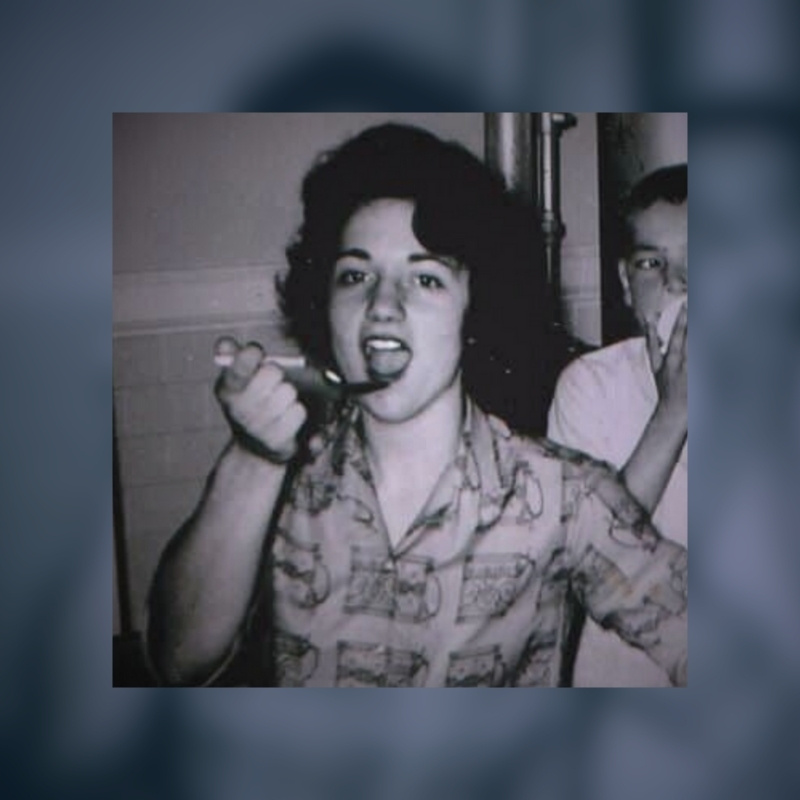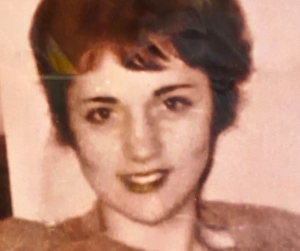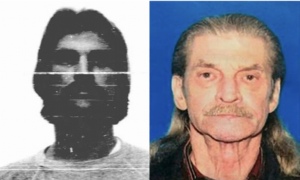Daylight was fading on March 14, 1968. Though the sun was sinking fast, a few young boys were still out playing, exploring a large dirt field at the corner of Newland Street and Yorktown Avenue in Huntington Beach.
Today, that intersection is covered by rows and rows of single-story houses with terracotta tiled roofs. But in March of 1968, there wasn’t a house in sight. Instead, it was oil field after oil field with drainage ditches in between. On that day as the boys played, they spotted something unusual in one of the ditches. The boys later said that they had believed they were seeing a scarecrow fallen from its post into the ditch. But as they approached, the truth of what lay there between oil fields was made clear – it was the body of a young woman.
The woman appeared to have been dead for just a few hours, and had been brutally attacked. Investigators scoured the scene for clues, finding shoe imprints, marks from tires, and a cigarette butt, but it had rained the night before and so any other evidence left behind had likely washed away.
Huntington Beach police labeled the woman a Jane Doe and set out to investigate her identity and her death, but the woman found there would not have her name returned to her for more than half a century.
Huntington Beach Police are still trying to determine how the victim and suspect knew each other and other details of the crime. If you recognize either Anita Piteau or Johnny Chrisco, they ask that you please contact the Huntington Beach Police Tip Line at 714-375-5066.
About the Era
The 1960s in the United States represented significant cultural upheaval as the country faced tensions between more traditional, conservative values and newer, nonconformist lifestyles. The tensions between these beliefs were all book-ended by the war in Vietnam, which began in 1955 and ended in 1975, though the United States entered in 1965.
For many young people during the period, the decision to enter the war highlighted the importance of peaceful values and sparked many anti-conflict protests. These years were also full of youth living a nomadic lifestyle and exploring the world. In 2016, speaking retrospectively, Huntington Beach Police Chief Robert Handy told the Daily Pilot that, “If you think about that era, there was a lot of hitchhiking, there was a lot of cross-country travel. It was kind of a free-spirit time, and during the height of the Vietnam era, a lot of people were traveling and living this free-spirit lifestyle.”
The music of the period further defined the 1960s. When people think of the 1960s today, they think of the Beatles, the Rolling Stones, and a general melding of blues and rock. People think of the Summer of Love, 1967, and of Woodstock in 1969. The artistic movements and festivals of the time represented the common ideal of peace and love, leading hundreds of thousands of people to seek connection with one another.
In the small cities of Maine, change was afoot, too. The state that is still known for its tremendous tracts of undisturbed pine trees, its blueberry fields, and its oceans, was just beginning to develop as its population slowly increased. Its capital city, Augusta, had once been primarily farmland. But in 1967, the department store giant Sears had finally moved in. Maine also elected its youngest governor, Democrat Kenneth M. Curtis, who was just 35 years old. The state that is and was, in many ways, slow to veer away from its history and traditions was open to trying something new.
The so-called “hippie movement” represented in the most popular music and in the more risque films coming out of Hollywood was also making its way to Maine, impressing new ideas on teenagers and young twenty-somethings in the state.
About Anita Piteau
For Anita Louise Piteau, these years were woven into the fabric of her identity. Born on March 9, 1942 in Augusta, Maine, Anita was in her twenties during the 1960s. She was discovering herself. She had dark eyes and styled her short, dark hair in tall ringlets that were reminiscent of Old Hollywood. She frequently wore brightly colored and patterned clothing. Beyond her appearance, Anita’s energy simply set her apart from her surroundings.
Anita had grown up in Central Maine and was one of the seven children of Rena and George Piteau. Throughout her childhood and into her adulthood, she was extremely close with her family. Anita’s niece, Laurie Quirion, later described Anita to WGME as “always very fun and happy.” And she may have been a free-spirited person even as a young teen.
A December 1, 1955 article in the Kennebec Journal, it details Anita’s recurrent absences from school. According to the report, 13-year-old Anita had missed eighteen days of school in just the month and a half since she had enrolled in her middle school class. This was almost two-thirds of the days that Anita should have been in class, and was not acceptable to the school district. This resulted in her mother, Rena Piteau, being fined for her daughter’s truancy; meanwhile, Rena claimed that she did not know her daughter was not attending school. Even as a young teen, Anita didn’t like to be tied down; she was a wanderer, and that trait stuck throughout her life.
This free-spirited, wandering soul and adventurous essence, combined with the backdrop of the 1967 Summer of Love and the Hollywood glamor after which Anita styled herself, drove 25-year-old Anita Louise Piteau to search for herself on the other side of the country, away from her small hometown and rural home state. Anita Piteau left for Los Angeles in 1967, which is about as far away from Maine as she could get without leaving the continental United States.
Though far away, she wrote to her family often, describing her new life, the people she met, and the things that she learned. Her family in Augusta enjoyed hearing of these new experiences, looking forward to each new letter. But one day, in February of 1968, the letters suddenly stopped.
No More Letters
When the Piteau family stopped receiving letters from California to their home in Augusta, they began to worry. While Anita had always been a free spirit, she was also deeply loyal to her family. Ever since her cross-country road trip had landed her in California, where her dreams of adventures in Hollywood lived, she had been sure to stay in touch with her loved ones. It was not like her to stop all communication.
As time went on, their worry compounded. The family debated flying across the country in search of Anita, but Rena and George did not have a lot of excess income and needed to support their large family in Maine. And where would they even begin? So, they stayed home and waited, hoping Anita would call, that she would write, waiting for any news at all.
Discovery
When the young boys playing in the oil fields of Huntington Beach found the deceased woman in March of 1968, she had been dead for only a few hours. Sometime between the night of March 13 and the early evening of March 14, 1968, Anita had been assaulted, severely beaten, and her throat had been slit. She was left in that ditch wearing disheveled clothing, with bruises covering her body and face.
When police arrived on the scene, they carefully collected every bit of evidence they could find. They noted her appearance, her clothing, her shoes, and her jewelry. According to police records, detectives speculated that she was between 20 and 30 years old, white or Latina, between 5’3” and 5’4” in height, and approximately 140 pounds in weight. She had dark, shoulder-length hair and distinctive teeth that would have formed a memorable smile. When the woman was found, she was wearing a floral blouse and purple pants, clothing that police noted was in style during the time period, along with a silver-colored ring with a large blue-green stone and Owego loafers.
Her appearance and her clothing led investigators to speculate that their Jane Doe was from outside of Southern California, judging in particular, by her brand of shoes. Owego shoes were made by the Endicott-Johnson Shoe Company, which was a New York brand located upstate. The brand only made that shoe available in New York at that time, leading detectives to believe that she may have been from the state of New York originally. This observation was extremely important, especially because there was little other evidence to follow.
While there were faint shoe prints and tire tracks, it had rained in Huntington Beach the previous night, wiping away any vulnerable clues that could have aided in the early investigation, but they did find a few key pieces of evidence. They located a used cigarette near the scene, which they collected and filed away. Police were also able to gather traces of another human from examinations of Anita’s body. Although there were few advancements in technology at the time, and detectives had no way of knowing that they would eventually be able to use DNA to solve cold cases, investigators saved everything.
On the same afternoon, not far from Anita’s body, two other children from the neighborhood made another discovery. In a different field, approximately a quarter of a mile away from the crime scene, they found a white purse with a matching white wallet. The wallet didn’t have any money or any identification in it to help in getting the purse back to its owner, but it did have six black and white photographs inside, with a seventh photo found near the purse in the field. They looked like family photos. The subjects were attending graduations and spending time with young children.
While investigators were uncertain that the purse or photographs were related to their Jane Doe, they noticed that the tire tracks near the purse were similar in appearance to those at their crime scene. They added these findings to the file as they continued their investigation.
Search for Her Identity
With minimal evidence and limited technology, the Huntington Beach Police Department was unsure where to begin. Just days after her body was found, the Los Angeles Times published that efforts to identify the young woman had been unsuccessful. The woman had no identifying marks or scars on her body. When her fingerprints were run with both the United States Federal Bureau of Investigation and the Mexican authorities, no matches were found.
Police told the Los Angeles Times that they planned to further examine the shoeprints and tire marks found at the scene. They noted that the tire marks matched a “late-model American car,” and they suspected that the same car had brought the woman to the scene and left her body there. The tracks indicated that the vehicle had come from the main road onto a dirt path in the field, stopping near where the woman’s body was later found. Investigators speculated that after abandoning the woman’s body in the ditch, the tracks continued further into the field, made a U-turn and returned to the road.
During the investigation, police continued to attempt to identify the woman by interviewing residents of the area to see if they recognized the victim. According to reporting by Steve Emmons for The LA Times, the bartender of a nearby establishment had initially told the police that he thought he did recognize her, saying that “he had seen the woman in the bar with a man earlier the previous night” and that she explained “she was new in town and had come from New York.”
He also noted that she had walked to the bar. She didn’t drive and wasn’t dropped off, and she didn’t come to the bar with anyone in their car. All these anecdotes aligned with what the police believed they already knew about their Jane Doe, given that her loafers were only sold in New York and that it appeared she was in someone else’s vehicle before or at least after she died.
The department sent twenty different police officers to canvas the neighborhood. They went from house to house, knocking on each door within walking distance from the bar to ask whether the residents knew the identity of the victim. The chief of detectives at the time, Captain Earl Robitaille, shared with the Los Angeles Times, “They referred us to about 125 persons who they thought might be the victim. None of the tips paid off.” Regardless, it seemed that the bartender’s story had been a dead end from the beginning. The Los Angeles Times shared that after this extensive search, the woman he saw in his bar that night, walked in again, alive and well.
With all tips leading nowhere, the Huntington Beach police cast a wider net. They searched for matches to the woman’s fingerprints, sent flyers with her description, photograph, and fingerprints to every police department in the country, and fielded many phone calls. Investigators worked to collect as much evidence as possible from the body, compiling “a record of hundreds of photographs, x-rays, tests and dental descriptions.” But it didn’t lead anywhere substantial at the time.
With no further leads or answers, the story of the unidentified woman in the oil field disappeared from the local consciousness for about a month. But then, ongoing strange events in the Huntington Beach area brought up her story at least once in mid-April of 1968.
Less than three weeks after the woman’s body was found, a 41-year-old Marine named Cecil T. Caldwell was shot by a sniper while standing outside his station in Huntington Beach. Before Caldwell passed away, he told detectives that he had not seen anyone prior to the shooting and that he did not know anyone with a motive to kill him. Police found a second bullet by the station, leading them to believe that the shooting had not been accidental. However, despite many searches and canvassing of the area, they were unable to find any witnesses or suspects.
Captain Robitaille told the Los Angeles Times that he did not believe the two cases to be related. However, the death of two individuals so close to one another – both with unidentified perpetrators and both without known motive – left the city feeling uneasy and unsafe.
The Huntington Beach Police Department’s energy around the case had slowly begun to fade as answers proved elusive. Investigators told the Los Angeles Times that they were “hoping for a break.” Robitaille saying, “We’re hoping some dense landlord around here finally calls the marshal’s office and says the woman he rented his room to hasn’t been around… and that she’s left all her stuff in the room. Then we’ll have something to start on.”
Despite the evidence, the diligence and attention to detail, and the public discussion of the crime, the case of the 1968 Huntington Beach Jane Doe went cold. For a long time, that was the only name she had. After nearly a month of tests and searching for answers, the woman was buried in an unmarked grave in Newport Beach, just six miles from where her body had been found. It would be decades before police and her family would learn that the woman was laid to rest more than 3,000 miles from home.
Episode Source Material
- Associated Press. “Constance Piteau Wed.” The Daily Kennebec Journal. 1 July 1958.
- Associated Press. “DNA identifies California 1968 homicide victim and suspect.” Boston.com. 24 July 2020.
- Associated Press. “DNA identifies Maine victim of 1968 California homicide.” Portland Press Herald. 23 July 2020.
- Associated Press. “DNA identifies Maine woman as 1968 California homicide victim.” WGME. 24 July 2020.
- Associated Press. “George J. Piteau.” The Daily Kennebec Journal. 18 January 1972.
- Associated Press. “DNA identifies Maine victim of 1968 California homicide.” WGME. 24 July 2020.
- Associated Press. “Maine’s largest Sears store opens in Augusta.” Kennebec Journal. 25 October 1967.
- Associated Press. “Mother Fined as Responsible for Truancy of Daughter, 13.” The Daily Kennebec Journal. 1 December 1955.
- Associated Press. “Orange County’s oldest Jane Doe cold case murder solved after 52 years.” ABC7. 24 July 2020.
- Associated Press. “Records Fail to Yield Slain Woman’s Identity.” The Los Angeles Times. 19 March 1968.
- Associated Press. “Rena E. Piteau.” The Morning Sentinel. 10 April 1996.
- Binion, Andrew. “Murderer in 1968 cold case never saw justice, living and dying in Bremerton.” Kitsap Sun. 29 July 2020.
- Dooling, Nancy. “1968 murder victim may have Owego ties.” Elmira Star-Gazette. 15 January 2011.
- Emmons, Steve. “No Solid Clues Found in 2 Puzzling Murders.” The Los Angeles Times. 15 April 1968.
- Fry, Hannah. “Who killed ‘Jane Doe’ found in 1968 in Huntington Beach? Who was she? Detectives again seek public’s help.” Los Angeles Daily Pilot. 17 November 2016.
- Harnisch, Larry. “Huntington Beach Jane Doe, 1968.” The Daily Mirror. 4 January 2011.
- Jabali-Nash, Naimah. “Calif. Police “Desperate to Identify” Murder Victim in 1968 Cold Case.” CBS News. 28 January 2011.
- Levenson, Michael. “A Half-Century Later, Police Identify a Homicide Suspect and His Victim.” The New York Times. 23 July 2020.
- Maine Historical Society. “Governor Kenneth Curtis, Augusta, ca. 1967.” Maine Memory Network.
- Orange County District Attorney. “Orange County’s Oldest Unsolved Jane Doe Murder Solved After 52-year Manhunt.” 23 July 2020.
- Reinhart, Russell. City of Huntington Beach Police Department Press Release. 4 January 2011.
- Reinhart, Russell. City of Huntington Beach Police Department Press Release. 11 January 2011.
- Sambines, Nick. “Family gets “sense of peace” after DNA identifies Maine woman as 1968 homicide victim.” Bangor Daily News. 23 July 2020.
- Sharon, Keith. “Huntington Beach Police Identity Oldest Jane Doe in Orange County.” The OC Register. 22 July 2020.
- Taylor, Alan. “50 Years Ago: A Look Back at 1967.” The Atlantic. 9 February 2017.


